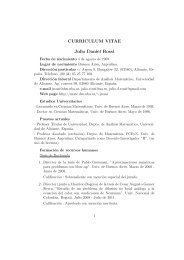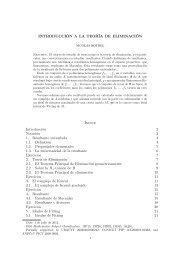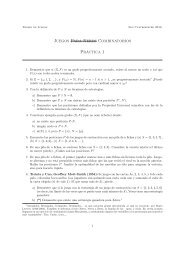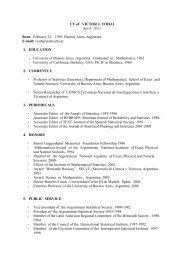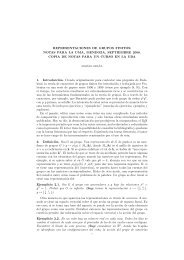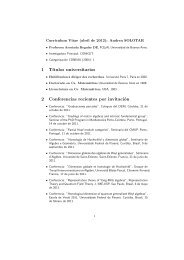Stochastic Differential Equations with explosions - Universidad de ...
Stochastic Differential Equations with explosions - Universidad de ...
Stochastic Differential Equations with explosions - Universidad de ...
You also want an ePaper? Increase the reach of your titles
YUMPU automatically turns print PDFs into web optimized ePapers that Google loves.
Introduction Explosions in evolution problems Numerical approximations Adaptive numerical scheme<br />
<strong>Stochastic</strong> <strong>Differential</strong> <strong>Equations</strong> <strong>with</strong> <strong>explosions</strong><br />
Pablo Groisman<br />
University of Buenos Aires<br />
Joint work <strong>with</strong><br />
J. Dávila, U. <strong>de</strong> Chile<br />
J. Fernán<strong>de</strong>z Bon<strong>de</strong>r, UBA<br />
J.D. Rossi, UBA<br />
M. Sued, UBA<br />
Pablo Groisman UBA<br />
<strong>Stochastic</strong> <strong>Differential</strong> <strong>Equations</strong> <strong>with</strong> <strong>explosions</strong>
Introduction Explosions in evolution problems Numerical approximations Adaptive numerical scheme<br />
The Problem<br />
dx = b(x) dt + σ(x) dW<br />
x(0) = z ∈ R>0<br />
◮ W is a one dimensional Wiener process (dW is “white noise”)<br />
◮ b, σ are smooth and positive.<br />
That is . . .<br />
Pablo Groisman UBA<br />
<strong>Stochastic</strong> <strong>Differential</strong> <strong>Equations</strong> <strong>with</strong> <strong>explosions</strong>
Introduction Explosions in evolution problems Numerical approximations Adaptive numerical scheme<br />
The Problem<br />
dx = b(x) dt + σ(x) dW<br />
x(0) = z ∈ R>0<br />
◮ W is a one dimensional Wiener process (dW is “white noise”)<br />
◮ b, σ are smooth and positive.<br />
That is . . .<br />
x = x(t) = x(ω, t) is a stochastic process that verifies<br />
t<br />
t<br />
x(t) = z + b(x(s)) ds + σ(x(s)) dW (s).<br />
0<br />
0<br />
Pablo Groisman UBA<br />
<strong>Stochastic</strong> <strong>Differential</strong> <strong>Equations</strong> <strong>with</strong> <strong>explosions</strong>
Introduction Explosions in evolution problems Numerical approximations Adaptive numerical scheme<br />
The Problem<br />
dx = b(x) dt + σ(x) dW<br />
x(0) = z ∈ R>0<br />
◮ W is a one dimensional Wiener process (dW is “white noise”)<br />
◮ b, σ are smooth and positive.<br />
That is . . .<br />
x = x(t) = x(ω, t) is a stochastic process that verifies<br />
t<br />
t<br />
x(t) = z + b(x(s)) ds + σ(x(s)) dW (s).<br />
0<br />
0<br />
If b is not globally Lipschitz, solutions to this problem may explo<strong>de</strong><br />
in finite time.<br />
Pablo Groisman UBA<br />
<strong>Stochastic</strong> <strong>Differential</strong> <strong>Equations</strong> <strong>with</strong> <strong>explosions</strong>
Introduction Explosions in evolution problems Numerical approximations Adaptive numerical scheme<br />
ODE vs. SDE<br />
x(t) x(t)<br />
Pablo Groisman UBA<br />
<strong>Stochastic</strong> <strong>Differential</strong> <strong>Equations</strong> <strong>with</strong> <strong>explosions</strong>
Introduction Explosions in evolution problems Numerical approximations Adaptive numerical scheme<br />
Explosions<br />
There exist a stopping time T such<br />
that x(ω, t) is <strong>de</strong>fined in [0, T (ω)),<br />
but<br />
x(ω, t) ↗ +∞ as t ↗ T (ω).<br />
Pablo Groisman UBA<br />
<strong>Stochastic</strong> <strong>Differential</strong> <strong>Equations</strong> <strong>with</strong> <strong>explosions</strong>
Introduction Explosions in evolution problems Numerical approximations Adaptive numerical scheme<br />
Fatigue Cracking<br />
◮ This kind of SDE are used, for<br />
example, to mo<strong>de</strong>l fatigue<br />
cracking (fatigue failures in solid<br />
materials)<br />
◮ x(t) represents the evolution of<br />
the length of the largest crack.<br />
◮ The explosion time corresponds<br />
to the time of ultimate damage<br />
or fatigue failure in the material.<br />
Pablo Groisman UBA<br />
<strong>Stochastic</strong> <strong>Differential</strong> <strong>Equations</strong> <strong>with</strong> <strong>explosions</strong>
Introduction Explosions in evolution problems Numerical approximations Adaptive numerical scheme<br />
Explosions in evolution problems<br />
Pablo Groisman UBA<br />
<strong>Stochastic</strong> <strong>Differential</strong> <strong>Equations</strong> <strong>with</strong> <strong>explosions</strong>
Introduction Explosions in evolution problems Numerical approximations Adaptive numerical scheme<br />
Explosions in evolution problems<br />
1. ODE: ˙x(t) = b(x(t)).<br />
Pablo Groisman UBA<br />
<strong>Stochastic</strong> <strong>Differential</strong> <strong>Equations</strong> <strong>with</strong> <strong>explosions</strong>
Introduction Explosions in evolution problems Numerical approximations Adaptive numerical scheme<br />
Explosions in evolution problems<br />
1. ODE: ˙x(t) = b(x(t)). Blow-up ⇐⇒ T = +∞<br />
x(0)<br />
the blow-up time<br />
1<br />
b < ∞. T is<br />
Pablo Groisman UBA<br />
<strong>Stochastic</strong> <strong>Differential</strong> <strong>Equations</strong> <strong>with</strong> <strong>explosions</strong>
Introduction Explosions in evolution problems Numerical approximations Adaptive numerical scheme<br />
Explosions in evolution problems<br />
1. ODE: ˙x(t) = b(x(t)). Blow-up ⇐⇒ T = +∞<br />
the blow-up time<br />
2. Nonlinear parabolic PDE: ut = ∆u + b(u)<br />
x(0)<br />
1<br />
b < ∞. T is<br />
Pablo Groisman UBA<br />
<strong>Stochastic</strong> <strong>Differential</strong> <strong>Equations</strong> <strong>with</strong> <strong>explosions</strong>
Introduction Explosions in evolution problems Numerical approximations Adaptive numerical scheme<br />
Explosions in evolution problems<br />
1. ODE: ˙x(t) = b(x(t)). Blow-up ⇐⇒ T = +∞<br />
x(0)<br />
the blow-up time<br />
2. Nonlinear parabolic PDE: ut = ∆u + b(u) .<br />
◮ There exists solutions <strong>with</strong> blow-up if +∞ 1<br />
b<br />
1963. Fujita, 1966).<br />
1<br />
b < ∞. T is<br />
< ∞ (Kaplan,<br />
Pablo Groisman UBA<br />
<strong>Stochastic</strong> <strong>Differential</strong> <strong>Equations</strong> <strong>with</strong> <strong>explosions</strong>
Introduction Explosions in evolution problems Numerical approximations Adaptive numerical scheme<br />
Explosions in evolution problems<br />
1. ODE: ˙x(t) = b(x(t)). Blow-up ⇐⇒ T = +∞<br />
x(0)<br />
the blow-up time<br />
2. Nonlinear parabolic PDE: ut = ∆u + b(u) .<br />
◮ There exists solutions <strong>with</strong> blow-up if +∞ 1<br />
b<br />
1<br />
b < ∞. T is<br />
< ∞ (Kaplan,<br />
1963. Fujita, 1966).<br />
◮ No closed criteria to <strong>de</strong>ci<strong>de</strong> if blow-up will occur.<br />
Pablo Groisman UBA<br />
<strong>Stochastic</strong> <strong>Differential</strong> <strong>Equations</strong> <strong>with</strong> <strong>explosions</strong>
Introduction Explosions in evolution problems Numerical approximations Adaptive numerical scheme<br />
Explosions in evolution problems<br />
1. ODE: ˙x(t) = b(x(t)). Blow-up ⇐⇒ T = +∞<br />
x(0)<br />
the blow-up time<br />
2. Nonlinear parabolic PDE: ut = ∆u + b(u) .<br />
◮ There exists solutions <strong>with</strong> blow-up if +∞ 1<br />
b<br />
1963. Fujita, 1966).<br />
◮ No closed criteria to <strong>de</strong>ci<strong>de</strong> if blow-up will occur.<br />
◮ No explicit formula for the blow-up time.<br />
1<br />
b < ∞. T is<br />
< ∞ (Kaplan,<br />
Pablo Groisman UBA<br />
<strong>Stochastic</strong> <strong>Differential</strong> <strong>Equations</strong> <strong>with</strong> <strong>explosions</strong>
Introduction Explosions in evolution problems Numerical approximations Adaptive numerical scheme<br />
Explosions in evolution problems<br />
1. ODE: ˙x(t) = b(x(t)). Blow-up ⇐⇒ T = +∞<br />
x(0)<br />
the blow-up time<br />
2. Nonlinear parabolic PDE: ut = ∆u + b(u) .<br />
1<br />
b < ∞. T is<br />
< ∞ (Kaplan,<br />
◮ There exists solutions <strong>with</strong> blow-up if +∞ 1<br />
b<br />
1963. Fujita, 1966).<br />
◮ No closed criteria to <strong>de</strong>ci<strong>de</strong> if blow-up will occur.<br />
◮ No explicit formula for the blow-up time.<br />
◮ The phenomenon is very well un<strong>de</strong>rstood (blow-up times,<br />
blow-up sets, blow-up rates, numerical computation of<br />
solutions, etc.)<br />
Pablo Groisman UBA<br />
<strong>Stochastic</strong> <strong>Differential</strong> <strong>Equations</strong> <strong>with</strong> <strong>explosions</strong>
Introduction Explosions in evolution problems Numerical approximations Adaptive numerical scheme<br />
Explosions in evolution problems<br />
3. SDE: The Feller Test for Explosions provi<strong>de</strong>s a precise criteria<br />
to <strong>de</strong>termine, in terms of b and σ whether solutions explo<strong>de</strong><br />
<strong>with</strong> probability zero, positive or one.<br />
Pablo Groisman UBA<br />
<strong>Stochastic</strong> <strong>Differential</strong> <strong>Equations</strong> <strong>with</strong> <strong>explosions</strong>
Introduction Explosions in evolution problems Numerical approximations Adaptive numerical scheme<br />
Explosions in evolution problems<br />
3. SDE: The Feller Test for Explosions provi<strong>de</strong>s a precise criteria<br />
to <strong>de</strong>termine, in terms of b and σ whether solutions explo<strong>de</strong><br />
<strong>with</strong> probability zero, positive or one.<br />
Examples:<br />
1. dx = (1 + x 2 ) dt + dW → P(explosion in finite time) = 1<br />
Pablo Groisman UBA<br />
<strong>Stochastic</strong> <strong>Differential</strong> <strong>Equations</strong> <strong>with</strong> <strong>explosions</strong>
Introduction Explosions in evolution problems Numerical approximations Adaptive numerical scheme<br />
Explosions in evolution problems<br />
3. SDE: The Feller Test for Explosions provi<strong>de</strong>s a precise criteria<br />
to <strong>de</strong>termine, in terms of b and σ whether solutions explo<strong>de</strong><br />
<strong>with</strong> probability zero, positive or one.<br />
Examples:<br />
1. dx = (1 + x 2 ) dt + dW → P(explosion in finite time) = 1<br />
2. b and σ globally Lipschitz. → P(exp. in finite time) = 0<br />
Pablo Groisman UBA<br />
<strong>Stochastic</strong> <strong>Differential</strong> <strong>Equations</strong> <strong>with</strong> <strong>explosions</strong>
Introduction Explosions in evolution problems Numerical approximations Adaptive numerical scheme<br />
Explosions in evolution problems<br />
3. SDE: The Feller Test for Explosions provi<strong>de</strong>s a precise criteria<br />
to <strong>de</strong>termine, in terms of b and σ whether solutions explo<strong>de</strong><br />
<strong>with</strong> probability zero, positive or one.<br />
Examples:<br />
1. dx = (1 + x 2 ) dt + dW → P(explosion in finite time) = 1<br />
2. b and σ globally Lipschitz. → P(exp. in finite time) = 0<br />
3. Poner prob positivia<br />
Pablo Groisman UBA<br />
<strong>Stochastic</strong> <strong>Differential</strong> <strong>Equations</strong> <strong>with</strong> <strong>explosions</strong>
Introduction Explosions in evolution problems Numerical approximations Adaptive numerical scheme<br />
Explosions in evolution problems<br />
3. SDE: The Feller Test for Explosions provi<strong>de</strong>s a precise criteria<br />
to <strong>de</strong>termine, in terms of b and σ whether solutions explo<strong>de</strong><br />
<strong>with</strong> probability zero, positive or one.<br />
Examples:<br />
1. dx = (1 + x 2 ) dt + dW → P(explosion in finite time) = 1<br />
2. b and σ globally Lipschitz. → P(exp. in finite time) = 0<br />
3. Poner prob positivia<br />
4.<br />
◮ 0 < C1 ≤ σ 2 (s) ≤ C2b(s).<br />
∞<br />
1<br />
◮ b(s) is non<strong>de</strong>creasing for s > s0 and ds < ∞<br />
b(s)<br />
P(explosion in finite time) = 1<br />
Pablo Groisman UBA<br />
<strong>Stochastic</strong> <strong>Differential</strong> <strong>Equations</strong> <strong>with</strong> <strong>explosions</strong>
Introduction Explosions in evolution problems Numerical approximations Adaptive numerical scheme<br />
Explosions in evolution problems<br />
4. SPDE: ut = uxx + u p ˙W .<br />
Pablo Groisman UBA<br />
<strong>Stochastic</strong> <strong>Differential</strong> <strong>Equations</strong> <strong>with</strong> <strong>explosions</strong>
Introduction Explosions in evolution problems Numerical approximations Adaptive numerical scheme<br />
Explosions in evolution problems<br />
4. SPDE: ut = uxx + u p ˙W . Blow-up if p > 3/2. Global solutions<br />
if p < 3/2 (C. Mueller, 2000)<br />
Pablo Groisman UBA<br />
<strong>Stochastic</strong> <strong>Differential</strong> <strong>Equations</strong> <strong>with</strong> <strong>explosions</strong>
Introduction Explosions in evolution problems Numerical approximations Adaptive numerical scheme<br />
Explosions in evolution problems<br />
4. SPDE: ut = uxx + u p ˙W . Blow-up if p > 3/2. Global solutions<br />
if p < 3/2 (C. Mueller, 2000)<br />
Both for SDE and SPDE:<br />
Pablo Groisman UBA<br />
<strong>Stochastic</strong> <strong>Differential</strong> <strong>Equations</strong> <strong>with</strong> <strong>explosions</strong>
Introduction Explosions in evolution problems Numerical approximations Adaptive numerical scheme<br />
Explosions in evolution problems<br />
4. SPDE: ut = uxx + u p ˙W . Blow-up if p > 3/2. Global solutions<br />
if p < 3/2 (C. Mueller, 2000)<br />
Both for SDE and SPDE: No further results on (for example)<br />
the behavior of the explosion time, the set where <strong>explosions</strong> occur,<br />
numerical computation of the solutions, etc.<br />
Pablo Groisman UBA<br />
<strong>Stochastic</strong> <strong>Differential</strong> <strong>Equations</strong> <strong>with</strong> <strong>explosions</strong>
Introduction Explosions in evolution problems Numerical approximations Adaptive numerical scheme<br />
Our work...<br />
◮ Theoretical study of the regularity of the explosion time<br />
Pablo Groisman UBA<br />
<strong>Stochastic</strong> <strong>Differential</strong> <strong>Equations</strong> <strong>with</strong> <strong>explosions</strong>
Introduction Explosions in evolution problems Numerical approximations Adaptive numerical scheme<br />
Our work...<br />
◮ Theoretical study of the regularity of the explosion time<br />
◮ Numerical approximations for this kind of problems<br />
Pablo Groisman UBA<br />
<strong>Stochastic</strong> <strong>Differential</strong> <strong>Equations</strong> <strong>with</strong> <strong>explosions</strong>
Introduction Explosions in evolution problems Numerical approximations Adaptive numerical scheme<br />
Numerical approximations<br />
We assume<br />
◮ 0 < C1 ≤ σ 2 (s) ≤ C2b(s).<br />
◮ b(s) is non<strong>de</strong>creasing for s > s0 and<br />
∞ 1<br />
ds < ∞.<br />
b(s)<br />
Un<strong>de</strong>r these conditions, <strong>explosions</strong> occur <strong>with</strong> probability one.<br />
Example:<br />
dx = (1 + x 2 ) dt + dW<br />
Pablo Groisman UBA<br />
<strong>Stochastic</strong> <strong>Differential</strong> <strong>Equations</strong> <strong>with</strong> <strong>explosions</strong>
Introduction Explosions in evolution problems Numerical approximations Adaptive numerical scheme<br />
What features we expect from a numerical method<br />
for this kind of problems?<br />
Pablo Groisman UBA<br />
<strong>Stochastic</strong> <strong>Differential</strong> <strong>Equations</strong> <strong>with</strong> <strong>explosions</strong>
Introduction Explosions in evolution problems Numerical approximations Adaptive numerical scheme<br />
What features we expect from a numerical method<br />
for this kind of problems?<br />
◮ Convergence of the numerical solutions to the continuous one.<br />
Pablo Groisman UBA<br />
<strong>Stochastic</strong> <strong>Differential</strong> <strong>Equations</strong> <strong>with</strong> <strong>explosions</strong>
Introduction Explosions in evolution problems Numerical approximations Adaptive numerical scheme<br />
What features we expect from a numerical method<br />
for this kind of problems?<br />
◮ Convergence of the numerical solutions to the continuous one.<br />
◮ Explosions in the numerical solutions for small choices of the<br />
parameter of the method.<br />
Pablo Groisman UBA<br />
<strong>Stochastic</strong> <strong>Differential</strong> <strong>Equations</strong> <strong>with</strong> <strong>explosions</strong>
Introduction Explosions in evolution problems Numerical approximations Adaptive numerical scheme<br />
What features we expect from a numerical method<br />
for this kind of problems?<br />
◮ Convergence of the numerical solutions to the continuous one.<br />
◮ Explosions in the numerical solutions for small choices of the<br />
parameter of the method.<br />
◮ Convergence of the numerical explosion times to the<br />
continuous one.<br />
Pablo Groisman UBA<br />
<strong>Stochastic</strong> <strong>Differential</strong> <strong>Equations</strong> <strong>with</strong> <strong>explosions</strong>
Introduction Explosions in evolution problems Numerical approximations Adaptive numerical scheme<br />
The Euler-Maruyama scheme (for boun<strong>de</strong>d solutions)<br />
0<br />
dx = b(x) dt + σ(x) dW<br />
h<br />
t i t i+1<br />
Xi ≈ x(ti)<br />
h = ti+1 − ti, ∆Wi = W (ti+1) − W (ti).<br />
Xi+1 = Xi + hb(Xi) + σ(Xi)∆Wi, X0 = x(0) = z,<br />
Pablo Groisman UBA<br />
<strong>Stochastic</strong> <strong>Differential</strong> <strong>Equations</strong> <strong>with</strong> <strong>explosions</strong><br />
S
Introduction Explosions in evolution problems Numerical approximations Adaptive numerical scheme<br />
Xi+1 = Xi + hb(Xi) + σ(Xi)∆Wi<br />
◮ Not suitable for solutions <strong>with</strong> <strong>explosions</strong>! The numerical<br />
solution is <strong>de</strong>fined for every positive time.<br />
Pablo Groisman UBA<br />
<strong>Stochastic</strong> <strong>Differential</strong> <strong>Equations</strong> <strong>with</strong> <strong>explosions</strong>
Introduction Explosions in evolution problems Numerical approximations Adaptive numerical scheme<br />
Xi+1 = Xi + hb(Xi) + σ(Xi)∆Wi<br />
◮ Not suitable for solutions <strong>with</strong> <strong>explosions</strong>! The numerical<br />
solution is <strong>de</strong>fined for every positive time.<br />
◮ The time step h can not be constant. It must be adapted as<br />
the solution increases.<br />
Pablo Groisman UBA<br />
<strong>Stochastic</strong> <strong>Differential</strong> <strong>Equations</strong> <strong>with</strong> <strong>explosions</strong>
Introduction Explosions in evolution problems Numerical approximations Adaptive numerical scheme<br />
Xi+1 = Xi + hb(Xi) + σ(Xi)∆Wi<br />
◮ Not suitable for solutions <strong>with</strong> <strong>explosions</strong>! The numerical<br />
solution is <strong>de</strong>fined for every positive time.<br />
◮ The time step h can not be constant. It must be adapted as<br />
the solution increases.<br />
◮ We propose hi = h<br />
b(Xi ) . i.e. ti+1 − ti = h<br />
b(Xi )<br />
Xi+1 = Xi + hib(Xi) + σ(Xi)∆Wi = Xi + h + σ(Xi)∆Wi<br />
Pablo Groisman UBA<br />
<strong>Stochastic</strong> <strong>Differential</strong> <strong>Equations</strong> <strong>with</strong> <strong>explosions</strong>
Introduction Explosions in evolution problems Numerical approximations Adaptive numerical scheme<br />
The numerical solution<br />
X (ti) = Xi,<br />
X (t) = Xi+(t−ti)b(Xi)+σ(Xi)(W (t)−W (ti)), for t ∈ [ti, ti+1).<br />
is a well <strong>de</strong>fined process up to time<br />
Th =<br />
∞<br />
hi =<br />
i=1<br />
∞<br />
i=1<br />
h<br />
b(Xi) .<br />
We say that the numerical solution explo<strong>de</strong> in finite time Th if<br />
Th < ∞<br />
Pablo Groisman UBA<br />
<strong>Stochastic</strong> <strong>Differential</strong> <strong>Equations</strong> <strong>with</strong> <strong>explosions</strong>
Introduction Explosions in evolution problems Numerical approximations Adaptive numerical scheme<br />
Mean Square Convergence (while solutions are<br />
boun<strong>de</strong>d)<br />
Theorem 1: Fix a time S > 0 and a constant M > 0. Consi<strong>de</strong>r<br />
the stopping times given by<br />
Then<br />
R M := inf{t : x(t) = M} R M h<br />
τh = R M ∧ R M h<br />
:= inf{t : X (t) = M}<br />
∧ S<br />
lim<br />
h→0 E<br />
<br />
sup |x(t) − X (t)|<br />
0≤t≤τh<br />
2<br />
<br />
= 0.<br />
Pablo Groisman UBA<br />
<strong>Stochastic</strong> <strong>Differential</strong> <strong>Equations</strong> <strong>with</strong> <strong>explosions</strong>
Introduction Explosions in evolution problems Numerical approximations Adaptive numerical scheme<br />
Explosions in the Numerical Scheme<br />
Theorem 2:<br />
1. X (·) explo<strong>de</strong>s in finite time <strong>with</strong> probability one.<br />
Pablo Groisman UBA<br />
<strong>Stochastic</strong> <strong>Differential</strong> <strong>Equations</strong> <strong>with</strong> <strong>explosions</strong>
Introduction Explosions in evolution problems Numerical approximations Adaptive numerical scheme<br />
Explosions in the Numerical Scheme<br />
Theorem 2:<br />
1. X (·) explo<strong>de</strong>s in finite time <strong>with</strong> probability one.<br />
2. For every h > 0 we have,<br />
X (ti)<br />
lim<br />
i→∞ hi = 1 i.e X (ti) ∼ hi<br />
Pablo Groisman UBA<br />
<strong>Stochastic</strong> <strong>Differential</strong> <strong>Equations</strong> <strong>with</strong> <strong>explosions</strong>
Introduction Explosions in evolution problems Numerical approximations Adaptive numerical scheme<br />
Explosions in the Numerical Scheme<br />
Theorem 2:<br />
1. X (·) explo<strong>de</strong>s in finite time <strong>with</strong> probability one.<br />
2. For every h > 0 we have,<br />
X (ti)<br />
lim<br />
i→∞ hi = 1 i.e X (ti) ∼ hi<br />
(This is the asymptotic behavior of the numerical solution, since<br />
the behavior of<br />
can also be computed.)<br />
ti =<br />
i−1<br />
h<br />
b(Xj)<br />
j=1<br />
Pablo Groisman UBA<br />
<strong>Stochastic</strong> <strong>Differential</strong> <strong>Equations</strong> <strong>with</strong> <strong>explosions</strong>
Introduction Explosions in evolution problems Numerical approximations Adaptive numerical scheme<br />
Explosions in the Numerical Scheme<br />
Theorem 2:<br />
1. X (·) explo<strong>de</strong>s in finite time <strong>with</strong> probability one.<br />
2. For every h > 0 we have,<br />
X (ti)<br />
lim<br />
i→∞ hi = 1 i.e X (ti) ∼ hi<br />
(This is the asymptotic behavior of the numerical solution, since<br />
the behavior of<br />
ti =<br />
i−1<br />
h<br />
b(Xj)<br />
j=1<br />
can also be computed.)<br />
For example, if b(s) ∼ sp (p > 1), the explosion rate is<br />
X (ti)(Th − ti) 1/(p−1) 1<br />
1 p−1<br />
→<br />
as ti ↗ Th.<br />
p − 1<br />
Pablo Groisman UBA<br />
<strong>Stochastic</strong> <strong>Differential</strong> <strong>Equations</strong> <strong>with</strong> <strong>explosions</strong>
Introduction Explosions in evolution problems Numerical approximations Adaptive numerical scheme<br />
Proof:<br />
Xi+1 = Xi + hib(Xi) + σ(Xi)∆Wi = Xi + h + σ(Xi)∆Wi<br />
Pablo Groisman UBA<br />
<strong>Stochastic</strong> <strong>Differential</strong> <strong>Equations</strong> <strong>with</strong> <strong>explosions</strong>
Introduction Explosions in evolution problems Numerical approximations Adaptive numerical scheme<br />
Proof:<br />
Xi+1 = Xi + hib(Xi) + σ(Xi)∆Wi = Xi + h + σ(Xi)∆Wi<br />
Since “∆Wj ∼ N(0, hj)”,<br />
i<br />
j=1 σ(Xj)∆Wj<br />
Xi<br />
ih<br />
∼<br />
i<br />
→ 1 a.s., and hence<br />
∞<br />
τi =<br />
i=i0<br />
Xi+1 = z + ih +<br />
∞<br />
i=i0<br />
i<br />
j=1<br />
i<br />
σ(Xj)∆Wj<br />
j=1<br />
h<br />
b(Xj ) σ(Xj)Zj<br />
h<br />
b(Xi) ∼<br />
∞<br />
Xi0−1 i<br />
→ 0, then<br />
1<br />
du < +∞, a.s.<br />
b(u)<br />
Pablo Groisman UBA<br />
<strong>Stochastic</strong> <strong>Differential</strong> <strong>Equations</strong> <strong>with</strong> <strong>explosions</strong>
Introduction Explosions in evolution problems Numerical approximations Adaptive numerical scheme<br />
Convergence of the Numerical Explosion Times<br />
Theorem 3: For every ε > 0<br />
lim<br />
M→∞ lim<br />
h→0 P(|RM h<br />
R M h<br />
− T | > ε) = 0.<br />
:= inf{t : X (t) = M}<br />
Pablo Groisman UBA<br />
<strong>Stochastic</strong> <strong>Differential</strong> <strong>Equations</strong> <strong>with</strong> <strong>explosions</strong>
Introduction Explosions in evolution problems Numerical approximations Adaptive numerical scheme<br />
Numerical Experiments<br />
b(s) = |s| 1.1 + 0.1<br />
<br />
σ(s) = |s| 1.1 + 0.1<br />
z = 10<br />
M = 10 5<br />
1000 sample paths.<br />
2<br />
1.8<br />
1.6<br />
1.4<br />
1.2<br />
1<br />
0.8<br />
0.6<br />
0.4<br />
0.2<br />
h=1<br />
h=0.5<br />
h=0.01<br />
0<br />
3.2 3.4 3.6 3.8 4 4.2 4.4 4.6 4.8 5 5.2<br />
Kernel <strong>de</strong>nsity estimator of R M h .<br />
Pablo Groisman UBA<br />
<strong>Stochastic</strong> <strong>Differential</strong> <strong>Equations</strong> <strong>with</strong> <strong>explosions</strong>
Introduction Explosions in evolution problems Numerical approximations Adaptive numerical scheme<br />
Numerical Experiments<br />
b(s) = |s| 1.1 + 0.1<br />
<br />
σ(s) = |s| 1.1 + 0.1<br />
z = 10<br />
M = 10 5<br />
1000 sample paths.<br />
Asymptotic behavior of the numerical solution.<br />
Pablo Groisman UBA<br />
<strong>Stochastic</strong> <strong>Differential</strong> <strong>Equations</strong> <strong>with</strong> <strong>explosions</strong>
Introduction Explosions in evolution problems Numerical approximations Adaptive numerical scheme<br />
Numerical Experiments<br />
Some sample paths<br />
Pablo Groisman UBA<br />
<strong>Stochastic</strong> <strong>Differential</strong> <strong>Equations</strong> <strong>with</strong> <strong>explosions</strong>







